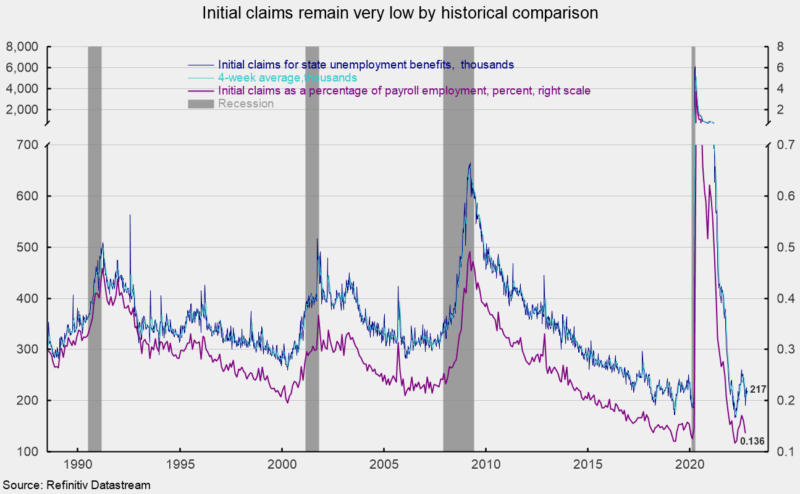Initial claims for regular state unemployment insurance fell by 1,000 for the week ending October 29th, coming in at 217,000. The previous week’s 218,000 was revised up from the initial estimate of 217,000 (see first chart). Claims have fallen in eight of the last 12 weeks, but the changes over the last five weeks have been small. When measured as a percentage of nonfarm payrolls, claims came in at 0.136 percent for September, down from 0.160 in August but above the record low of 0.117 in March. Overall, the level of weekly initial claims for unemployment insurance remains very low by historical comparison (see second chart).
The four-week average fell to 218,750, down 500 from the prior week. The four-week average peaked in early August and trended lower through the end of September but has risen slightly since the low. Overall, the data continue to suggest a tight labor market. However, continued elevated rates of price increases, an aggressive Fed tightening cycle, and fallout from the Russian invasion of Ukraine remain risks to the economic outlook.
The number of ongoing claims for state unemployment programs totaled 1.224 million for the week ending October 15th, an increase of 26,543 from the prior week (see third chart). State continuing claims had been trending higher from mid-May through the end of July but are now trending lower over the last few weeks (see third chart).
The latest results for the combined Federal and state programs put the total number of people claiming benefits in all unemployment programs at 1.251 million for the week ended October 15th, an increase of 28,929 from the prior week.
While the overall low level of initial claims suggests the labor market remains tight, a move lower in the number of open jobs raises some concern. The tight labor market is a crucial component of the economy, providing support for consumer spending. However, persistently elevated rates of price increases already weigh on consumer attitudes, and if consumers lose confidence in the labor market, they may significantly reduce spending. The outlook remains highly uncertain.




0 Comments